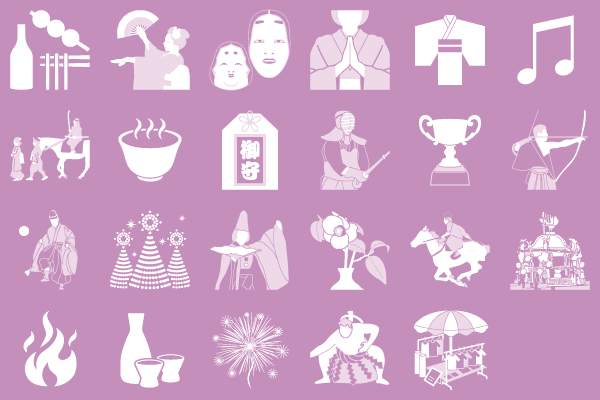Twenty-Five Bodhisattvas Procession Service|二十五菩薩お練り供養
Summary

Pure Land Buddhists believe in the salvation bestowed by Amida Buddha, a merciful figure who is said to grant rebirth in the Pure Land to those who utter the words “namu amida butsu” (“I take refuge in the compassion of Amida Buddha”). Buddhist art often represents this moment of deliverance by depicting Amida Buddha and his retinue of bodhisattvas descending on clouds to the side of the dying in order to escort them to the Pure Land with music, dance, and song.

At Sokujō-in, a sub-temple of the large Senyū-ji complex, this heavenly host is given shape each October in the form of Nijūgo Bosatsu Oneri Kuyō (Twenty-Five Bodhisattvas Procession Service).
Donning special helmet-like masks, golden halos, and rich brocade clothing, twenty-five participants transform themselves into holy boddhisatvas and make a pilgrimage on a raised bridge specially built between two halls on the temple property to recreate the image of Amida Buddha and his retinue’s sacred journey.
At 13:00, the service begins in the main hall before the temple’s statues of Amida Buddha and the twenty-five bodhisattvas, all of which are certified as Important Cultural Properties of Japan.
Dignified priests from the head temple Sennyū-ji lead the way for the first procession between the main hall and the temple’s Jizō-dō hall, with yamabushi mountain ascetics trumpeting on special conch shell instruments, gagaku musicians, and cute young children serving as chigo (sacred pages) escorted by proud kimono-clad parents.

Once the pages have placed their offerings at the altar in the Jizō-dō hall at the end of the bridge path, the retinue returns with flowers to offer at the main hall altar. For the second pass the pages carry golden platters filled with colorful paper “petals” that they scatter as they walk, and since they are considered good fortune, visitors raise their hands up to the bridge in appeal to receive them.
A special palanquin containing a treasure pagoda is carried onto the bridge as well… And for the third trip, temple parishioners chanting sutras and the masked “bodhisattvas” appear!
Lead by Jizō in bright orange and a mask more human-looking than the others’ golden features, the twenty five proceed across the bridge performing dances and carrying various instruments.
With the procession walking stately above the crowds heads to the sound of Sokujō-in’s wasan praise hymn, it may seem as if Amida’s heavenly host is truly passing between the Pure Land, represented by the main hall, and our mortal world, represented by the Jizo-dō hall.
After all the bodhisattvas have returned to the main hall, the treasure pagoda is removed from the palanquin and placed on a platform in the center of the hall. Then a votive performance called the Dance of the Pure Land is performed around it by three of the bodhisattvas: Kannon Bosatsu, Seishi Bosatsu, and Fugen Bosatsu. After the dance the participants offer up their final prayers before the altar, bringing Nijūgo Bosatsu Oneri Kuyō to an end.
With a thousand years of history behind it and very few other temples in the country performing similar rituals, the Nijūgo Bosatsu Oneri Kuyō ceremony at Sokujō-in is something the likes of which you won’t see anywhere else!
Things to See/Do

Reenactment

Buddhist Service

Period Costume

Parade

Charm
Schedule
2024 Schedule
October 20th, 13:00
Gallery
-




 +28
+28
Access
Address
〒605-0977 東山区泉涌寺山内町28
| TEL | 075-561-3443 |
| WEB | https://www.gensegokuraku.com/ |
Admission
- General Admission: Free
Hours
- General Admission: 09:00 – 16:00
